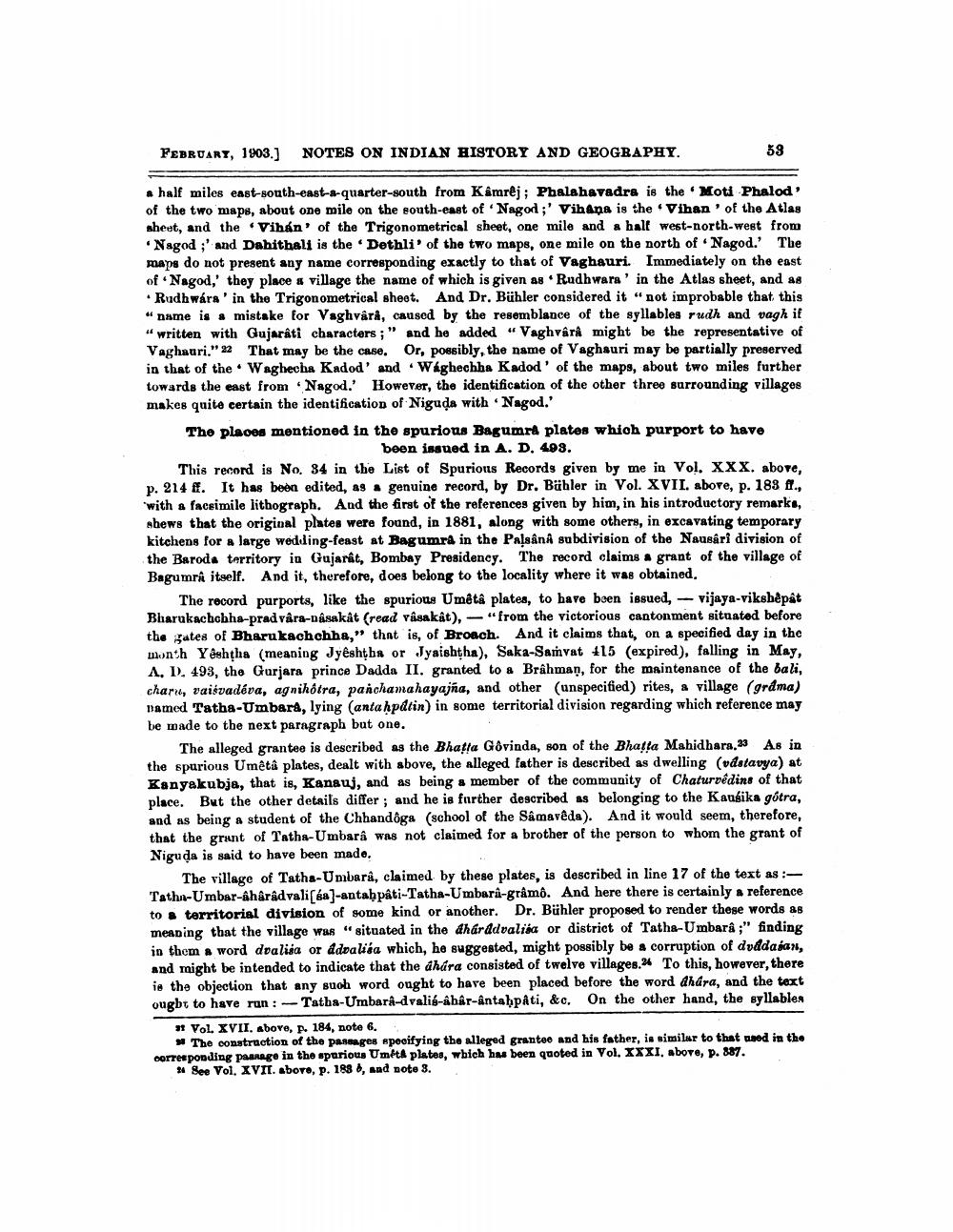________________
53
FEBRUARY, 1903.] NOTES ON INDIAN HISTORY AND GEOGRAPHY.
4
a half miles east-south-east-a-quarter-south from Kâmrej; Phalahavadra is the Moti Phalod' of the two maps, about one mile on the south-east of 'Nagod;' Vihana is the Vihan' of the Atlas sheet, and the Vihán' of the Trigonometrical sheet, one mile and a half west-north-west from 'Nagod;' and Dahithali is the Dethli' of the two maps, one mile on the north of Nagod.' The maps do not present any name corresponding exactly to that of Vaghauri. Immediately on the east of Nagod,' they place a village the name of which is given as Rudhwara' in the Atlas sheet, and as Rudhwárs' in the Trigonometrical sheet. And Dr. Bühler considered it "not improbable that this "name is a mistake for Vaghvârâ, caused by the resemblance of the syllables rudh and vagh it "written with Gujarati characters;" and he added "Vaghvârâ might be the representative of Vaghauri." 22 That may be the case. Or, possibly, the name of Vaghauri may be partially preserved in that of the Waghecha Kadod' and Waghechha Kadod' of the maps, about two miles further towards the east from Nagod.' However, the identification of the other three surrounding villages makes quite certain the identification of Niguda with 'Nagod.'
The places mentioned in the spurious Bagumra plates which purport to have
been issued in A. D. 493.
This record is No. 34 in the List of Spurious Records given by me in Vol. XXX. above, p. 214 ff. It has been edited, as a genuine record, by Dr. Bühler in Vol. XVII. above, p. 183 ff., with a facsimile lithograph. And the first of the references given by him, in his introductory remarks, shews that the original plates were found, in 1881, along with some others, in excavating temporary kitchens for a large wedding-feast at Bagumra in the Palsânâ subdivision of the Nausâri division of the Baroda territory in Gujarât, Bombay Presidency. The record claims a grant of the village of Bagumra itself. And it, therefore, does belong to the locality where it was obtained.
The record purports, like the spurious Umêtâ plates, to have been issued, vijaya-vikshêpât Bharukachchha-prad våra-násakât (read vasakât), "from the victorious cantonment situated before the gates of Bharukachchha," that is, of Broach. And it claims that, on a specified day in the month Yêshtha (meaning Jyêshtha or Jyaishtha), Saka-Samvat 415 (expired), falling in May, A. D. 493, the Gurjara prince Dadda II. granted to a Brahman, for the maintenance of the bali, charu, vaisvadéva, agnihotra, panchama hayajña, and other (unspecified) rites, a village (grama) named Tatha-Umbara, lying (anta ḥpatin) in some territorial division regarding which reference may be made to the next paragraph but one.
The alleged grantee is described as the Bhatta Govinda, son of the Bhatta Mahidhara, 23 As in the spurious Umêtâ plates, dealt with above, the alleged father is described as dwelling (vástavya) at Kanyakubja, that is, Kanauj, and as being a member of the community of Chaturvedins of that place. But the other details differ; and he is further described as belonging to the Kausika gótra, and as being a student of the Chhandôga (school of the Sâmavêda). And it would seem, therefore, that the grant of Tatha-Umbarâ was not claimed for a brother of the person to whom the grant of Niguda is said to have been made.
The village of Tatha-Umbarâ, claimed by these plates, is described in line 17 of the text as :Tatha-Umbar-âhârâdvali [éa]-antaḥpâti-Tatha-Umbarâ-grâmô. And here there is certainly a reference to a territorial division of some kind or another. Dr. Bühler proposed to render these words as meaning that the village was "situated in the dháradvalisa or district of Tatha-Umbarâ;" finding in them a word dvalisa or advalisa which, he suggested, might possibly be a corruption of dvddasan, and might be intended to indicate that the dhara consisted of twelve villages.24 To this, however, there is the objection that any such word ought to have been placed before the word dhára, and the text ought to have run: Tatha-Umbarâ-dvaliá-âbâr-ântaḥpâti, &c. On the other hand, the syllables
31 Vol. XVII. above, p. 184, note 6.
The construction of the passages specifying the alleged grantee and his father, is similar to that used in the corresponding passage in the spurious Umêt& plates, which has been quoted in Vol. XXXI. above, p. 887. 24 See Vol. XVII. above, p. 188 6, and note 3.




